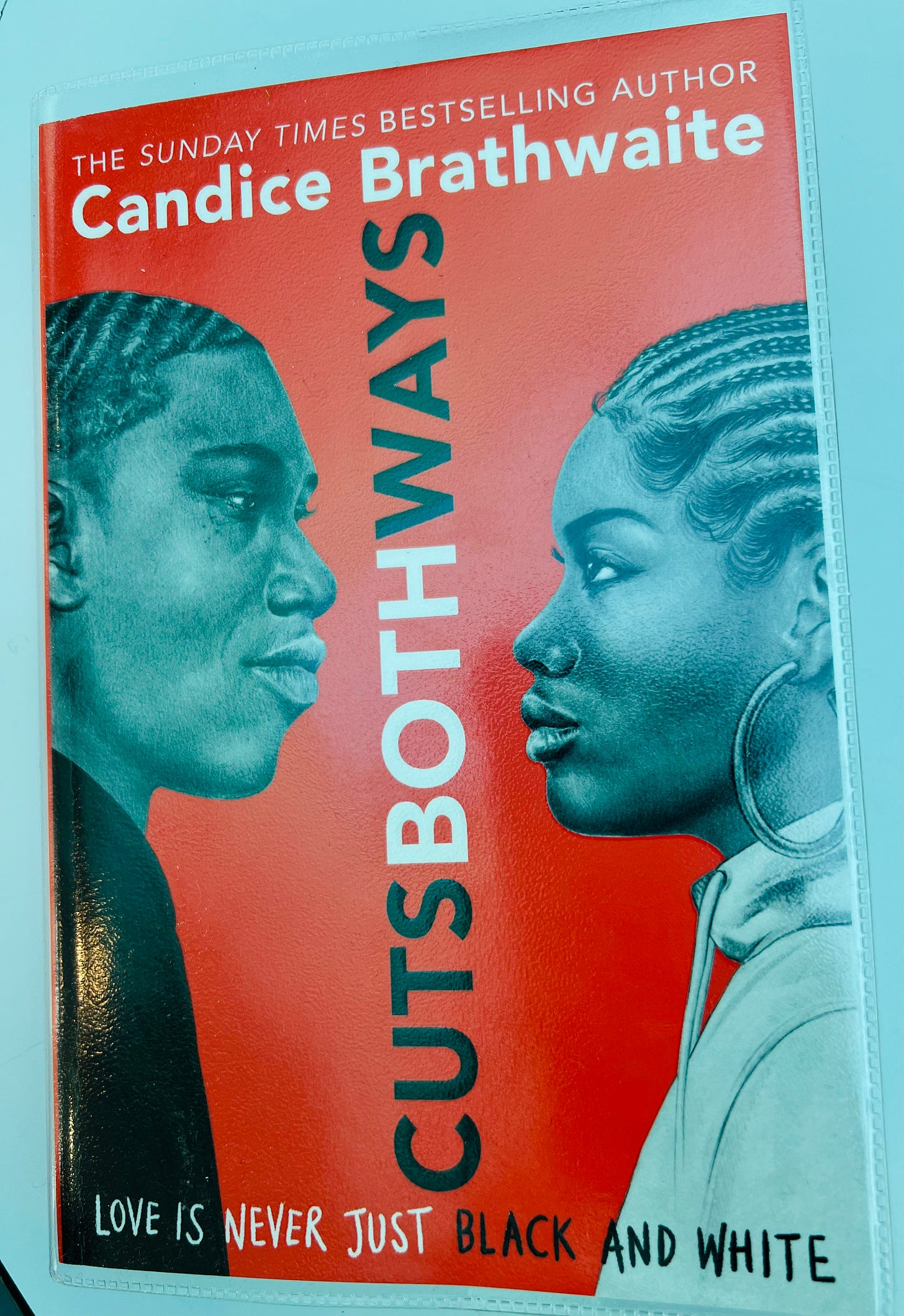It's Never Just Black and White
Identity in “Cuts Both Ways”
For “Drumline”
“Some would say it’s better to be judged by twelve than carried by six. Always remember either way many lives are changed forever. Walk easy. I love you.”
Cx
Cuts Both Ways begins with a reflective tone. From the outset, we are reminded that every decision we take can have far-reaching effects, not only on our own lives but also on those around us. It’s a plea to move through life with care, recognising that while justice might offer one form of judgment, the ultimate price of our actions may be much greater.
The story follows Nova, a young Black British teenager navigating the complexities of life in London. Proud of her heritage, Nova’s perspective begins to shift when she falls for a white boy named Leo. The novel delves into the challenges of their interracial relationship as Nova grapples with the expectations of her community and the judgments of others. Her relationship with Leo forces her to confront her own perceptions of race and identity, as well as the prejudices that exist both within and outside her community.
In today’s complex world, we all—particularly young people—face challenges related to choices, identity, belonging, and societal expectations. Candice Brathwaite’s Cuts Both Ways explores these issues in depth.
“I allowed myself to look at him, I mean really look at him. His skin was glowing and the waves in his hair were artfully brushed forward. He was close enough that I could make out the unmistakable warm scent of cocoa butter and something sweet and woody”
“I am both, and that’s okay.”
One of the most profound messages in Cuts Both Ways is the acceptance of a multifaceted identity. Brathwaite writes, “I am both, and that’s okay,” reflecting the internal struggle many young people face when they feel they must choose between different aspects of their identity.
The psychologist Carl Rogers wrote: “The curious paradox is that when I accept myself just as I am, then I can change.” This reminds us all about the importance of self-acceptance, including the complex and multifaceted aspects of our identity. By acknowledging and embracing all parts of ourselves, we open the door to personal development and a more authentic existence.
The philosopher Søren Kierkegaard supports the idea of embracing multiple identities and the complexities within when he states:
"The most common form of despair is not being who you are."
Remember that it’s okay to embody multiple identities and that these complexities make you who you are. Just as Kierkegaard suggests, true despair arises when we deny our true selves, highlighting that acknowledging and accepting the complexities within us is essential for authentic living.
You don’t have to fit into a single category—being multifaceted is a strength.
“It’s not about where you fit in, but where you feel at home.”
It is crucial to find spaces and communities where you feel accepted and valued for who you are, rather than trying to conform to external expectations.
The poet E.E. Cummings aligns beautifully with this idea:
"To be nobody but yourself in a world which is doing its best, night and day, to make you like everybody else, means to fight the hardest battle which any human being can fight; and never stop fighting."
This underscores the importance of finding spaces where you can be your true self, rather than conforming to external expectations. It highlights the struggle and the value of maintaining authenticity in a world that often pressures us to fit into moulds.
“Love doesn’t erase differences; it embraces them.”
Relationships, particularly interracial ones, can be complicated by societal attitudes and personal biases. Brathwaite’s insight that “Love doesn’t erase differences; it embraces them” offers a powerful perspective. It reminds us that love should not demand conformity or the erasure of identity but should celebrate diversity and uniqueness.
Carl Rogers aligns well with this sentiment when he writes:
"When I look at the world I'm pessimistic, but when I look at people I am optimistic."
There is a potential for deep, meaningful connections between individuals. Roger’s belief underscores the importance of understanding and appreciating the differences between people.
In your relationships, whether romantic or platonic, strive to understand and appreciate the differences that exist between you and others. True connection is built on respect, understanding, and a willingness to engage with each other’s backgrounds.
“You don’t have to be who they say you should be.”
Young people often face intense pressure to conform to societal norms. Brathwaite challenges this in Cuts Both Ways with the assertion, “You don’t have to be who they say you should be.” This is a call to resist the pressure to conform.
The psychiatrist Viktor Frankl aligns with this idea:
"Everything can be taken from a man but one thing: the last of the human freedoms—to choose one's attitude in any given set of circumstances, to choose one's own way."
Don’t be afraid to question and challenge societal expectations. Your path is your own, and you have the right to define what success, happiness, and identity mean for you.
“Life isn’t black and white, it’s all shades of grey.”
This reminder encapsulates the book’s core message: that life and identity are complex and cannot be reduced to simple categories.
Judith Butler, a contemporary philosopher once observed:
"We lose ourselves in what we read, only to return to ourselves, transformed and part of a more expansive world."
Resist the pressure to oversimplify your experiences or your identity. Embrace the grey areas and allow yourself to grow and evolve.
Candice Brathwaite’s Cuts Both Ways shows that we all, including the diverse young generation, can move forward with a deeper understanding of ourselves and the world around us. We should accept all aspects of our identity, seek out spaces where we feel at home, and approach relationships with an open heart. Remember, life is never just black and white—it’s rich, complex, and uniquely yours to explore.



